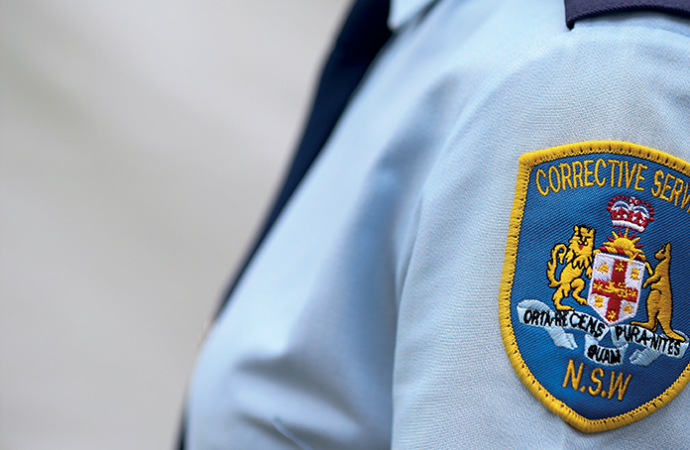How a botched prison escape left one man dead and another in a legal nightmare.

On a dark, rainy day in Lismore, it took just a few seconds for one man to lose his life and another man to have his world changed forever.
On 15 March 2019, circumstances brought two men to together. One was Dwayne Johnstone, a 43-year-old Aboriginal man who had appeared to suffer convulsions in the cells of Lismore Courthouse, where he was facing charges of assault. The other was a man whose identity was later suppressed by a court order and would henceforth become known to the media as Officer A.
On that day, Officer A’s job was to escort Mr Johnstone to Lismore Base Hospital.

Unknown to Officer A, while in hospital Mr Johnstone is alleged to have offered a nurse $10,000 if he helped him escape. Others in the ward described “demanding, threatening and intimidating” behaviour from Mr Johnstone towards other hospital staff members.
It was after the hospital visit, however, that Mr Johnstone broke free and made a bid for freedom.
“The entire incident went on for just over 10 seconds,” said Officer A, recalling the moment his life took a dramatic turn.
As the inmate raced off, away from his escort, the training NSW Prison Officers go through kicked in.
Officer A gave chase.

“I had to cross a four-lane road which included parking lanes at an ambulance entry and there were moving vehicles at the time,” said Officer A. “I had to ensure I knew where my fellow Officer was. This was as I was maintaining eyes on the escapee.
“It was quickly evident the inmate was running at speed. I gave the initial verbal warning for him to stop.”
As Mr Johnstone continued to run, Officer A drew his revolver, a .38-calibre Smith and Wesson, and yelled at the inmate to stop running.
Prison Officers performing court escort duties are issued with either a Glock or a Smith and Wesson. All Officers are given regular training with weapons, and for the overwhelming majority of them, this mandated time on the practice range is the only time they will fire their pistol in their entire career.
But for Officer A, 15 March 2019 was no ordinary day.
“I gave a verbal warning: ‘Correctional Officer; stop, or I will shoot’,” he said. “I then fired the first warning shot.
“But the escapee continued his intended escape, still running at speed.
“I then gave a second verbal warning: ‘Correctional Officer; stop, or I will shoot.’
“I then fired the second warning shot. But again, the escapee continued.

“It was clear in my assessment the escapee had no intention to stop. It was also clear that his intention was to get to the hospital public car park.
“I yelled, ‘F___ing stop!’”
It was now that Officer A knew Mr Johnstone had no intention of giving up his escape and a man accused of assault was about to be running free in the community. Every time Officer A had slowed down to fire a warning shop, the escapee had run further away.
“My focus was on preventing the escape,” he said. “I was unsure if someone was waiting for the escapee. Or a vehicle was parked there waiting for him. Then he would succeed in his escape. Members of the public were in that area and the situation would surely escalate to a much higher level.”
Determined to keep the public safe, Officer A fired a third shot.
“The third shot struck the inmate,” he said. The inmate continued to move forward and then fell. This all happened very quickly.
“I arrived where he was laying, he had rolled around onto his back and said a few words to me.”
Those words proved to be his last, and Mr Johnstone died at the scene.

Standing over the man who died trying to flee, Officer A had to contact police, although “I was highly elevated and somewhat confused and could not remember street names,” he said. “All I knew was that I had shot the escapee and was standing next to where he lay. Evidence came out that apparently, I placed my hand on my forehead and appeared extremely distressed. I cannot remember that, but I would say it is correct.”
Officer A spent the following days wondering how events had combined for such a tragic outcome.
“Of course, my mind continued to swirl for the next 72 hours as I had to undertake forensic and breath analysis process and go through that procedure,” he said. “I continually questioned myself to ensure all my actions were correct and look at anything else I could have done.
“I always ended up with the same conclusion. I had done as I was trained and there was nothing else I could have done.
“Obviously, discharging your firearm or any force is a last resort. But you would also think most people, after a warning shot was fired at them, would seriously consider stopping, let alone ignoring two warning shots.
“Unless of course he had a strong determination and will to get away and had a strategy or plan that would ensure his escape was successful.”
However, not everyone agreed with Officer A.
As the morning of the coronial inquest into Mr Johnstone’s death, Officer A was advised the matter was being referred to the Director of Public Prosecutions (DPP) with a recommendation that he be charged with manslaughter.
“This is without any evidence being heard by the coroner,” he said. “Only the coronial brief. This was despite no police charges and no internal disciplinary matters from their investigations. I can assure everyone the police conduct a thorough and complete investigation and are impartial in all aspects of inquiries.”
Suddenly the trauma of having killed a man was compounded with being charged with a criminal offence.
“I heard about the charges as my legal representatives travelled with Counsel Assisting on the plane to Ballina,” he said. “At this point in time, I had resumed duties back at the workplace, although on a return-to-work plan, which involved performing all day duties, including hospital escorts.
“I was shocked. The police investigation determined I had complied with legislation and determined I had no charges be laid against me. During the entire process with police I was never cautioned, as at no time did they detect or identify an offence had been committed.
“The internal investigation also indicated I had complied with training practices, policy and procedures, so no disciplinary action was taken. To this day I am still employed by Corrective Services, although I am on workers’ compensation.”
Since the referral from the Coroner to the DPP, Officer A has never returned to his workplace to perform the duties he had been performing.
When the first trial commenced, Officer A was thrust into the public spotlight. And with an issue as sensitive as Aboriginal deaths in custody, it wasn’t long until he was the target of online abuse.
“Initially social media blew up with, as you can imagine, a lot of threats harassment,” he said. “Where I lived, reprisals full of anger hatred came thick and fast against me and my family.
“After a period of time, it dropped off a bit. But due to the nature of the matter, after every court appearance, social media blew up again. This was generated by certain individuals and groups pushing their own agenda, misleading people to create anger.
“Some of these people attended my first mention date, and the Sheriff’s Officers overheard them discussing their actions and threats of what they intended to do when I came out of the courtroom.”
As a result, the magistrate declared a closed court. In addition, the threats directed at the Officer meant his name and identity were suppressed and remain so today.
“At various points along the way commencing with the coronial inquest groups held up placards and adopted certain positions outside the courthouse in an attempt to get a photo of me,” said Officer A.
Approximately six weeks before the first trial the DPP decided to upgrade the charge from manslaughter to murder. This was three-and-a-half years after the incident occurring. The DPP stated new evidence had been obtained. However, he believes nothing had changed since the incident.
Within a week of the upgrade Officer A was assaulted in the street while going for his morning walk. Police and Paramedics attended, but as the murder trial was due to commence, Officer A did not pursue any charges against his attacker.
“During the first trial, several people were questioned and some were arrested from the gallery for taking photos of me whilst in the courtroom,” he said.
“They had the pictures deleted from their phones and the Judge warned the Prosecution to speak with the supporters of the deceased and inform that he required certain dress to be worn in court and to remind them of rules about courtroom behaviour.”
The trial was tiring for the accused.
“At the end of each day, you are exhausted mentally,” he said. “However, you need to stay on your a-game as there is work to do to prepare for the next day. There are instructions to get and give from your legal team and they set tasks for you to complete so they can provide the best representation possible on your behalf.
“The trial went for around four or five weeks and the pre-trial hearing went for about three or four days. The jury remained out for a week and only asked one question. That week was like standing on the edge of a cliff not knowing if you will fall or stay put. A lot of conversations have to be had each day, because you wonder if a decision will be made that will mean this is the last time I see my family for a while. You wonder if you will be trucked out to a Correctional facility or go home. You live with uncertainty 24/7 until the jury returns.”
After the first trial, the jury was discharged after it was unable to reach a verdict on the charge of murder or manslaughter.
“The jury returned as a hung jury after being given what is called a ‘black direction’ by the presiding Judge,” said Officer A. “With that decision I was overwhelmed. We had planned for guilty or not guilty, but we never planned for a hung jury and retrial.”
A second trial began, and once again Officer A’s days revolved around the courthouse, wondering if he would once day join the inmates he once worked with.
“When the second trial began, I knew the amount of time and effort that my legal team had put in over the previous 12 months,” he said. “To this day and forever I am grateful to each and every person within the legal group that worked on my matter, from admin to Queen’s Counsel or, by the time the second trial came around, King’s Counsel.”
As a PSA member, Officer A had his legal bills met by his union and the POVB Legal Fund, saving him millions of dollars.
“The PSA were great all the way along,” he said. “I think people have a huge misunderstanding: you think you do your job as required within the rules and legislation, you will be covered.
“This is not correct. All those legal meetings and costs: travel costs, accommodation, meals, court appearances, the list goes on. I was in the Legal Fund so it was all covered. If I wasn’t: well, who can afford those sorts of costs these days?”
The legal fund is the main reason Officer A can tell his story, because it saved his life. Officer A had enough going on in his life without having to also think how he could raise several million dollars.
“The PSA POVB Legal Fund gives Prison Officers protection for events such as these,” said the union President Nicole Jess, herself an Officer. “Officer A would have had to choose between selling all his assets or compromising on his defence during the trial. As a union member, he had our support.
“It is imperative that you join your union.”
In addition to financial support, he was joined every day by fellow Prison Officers.
“Having fellow officers attend both trials gave myself and my family an immense amount of support and belief,” he said. “I also received many text messages from people far away who could not attend but they let me know their thoughts were with me.
“Fellow officers from Queensland, southern NSW and from various locations around the state attended from both private and public operating facilities and even some retired Officers. Officers I worked with in the mid-1980s were there and they gave me faith.
“Although I said hello for obvious reasons I couldn’t stop and talk too long and that didn’t bother them. They were there to show me that they fully supported me.
“There were some people I thought would or should attend yet failed to attend or communicate in any way. This was disheartening, yet I have learnt you work out who are the real supporters and which ones run and bury their heads.”
There was someone else constantly at the trial: Dwayne Johnstone’s mother.
“Once the jury retired, I asked my legal representatives if I could meet and show my remorse to the mother of the deceased,” he said. “I would have done this before or during evidence but that was not the appropriate time to do so. Once the jury retired after closing arguments my legal representative approached the mother and asked if she would like to meet with me. She immediately said, ‘Of course.’
“So when the court was adjourned, we both met.”
Officer A told the woman, “I am sorry for the situation that has occurred.”
“She replied with, ‘Come here and give me a hug,’” he said. “With that we embraced each other and talked about different things.
“Regardless of the circumstances this lady has lost her son and like any parent would be distraught. She did say we should not be here. As she heard the evidence during the trial she recognised I was only doing my job. We talked about her son’s childhood and opportunities that were not available back then that she wanted to get him into. There were programs were available but at a cost.
“She has not had an easy life and has endured many struggles and has done the absolute best she could with the circumstances she faced. After a few discussions and coffees, I learnt so much from her. She is such a strong and courageous woman, with the qualities many others would benefit from.
“I respect her in many ways. We both helped to ease each other’s pain and suffering.
“No-one wants a death in custody but there are many things to be learnt from the process that two people at other ends of the road can achieve if the matter is approached humanely and without judgement.”
The day of the second verdict was a nerve-racking event. Before the decision was handed down, his Barrister went through the scenarios, including making decisions on what assets were available to post bond and what prison he would request to be sent to if the verdict was guilty.
Instead the Officer A heard the two words he was desperate to hear for nearly four years: not guilty.
The verdict was delivered, as so often was the case, with Officer A’s partner in the courtroom.
“This type of event undoubtedly affects the family,” said Officer A. “How do you inform your children that you have been charged with murder? What do your partner’s parents think when they are told? How do any partners or their parents of our children react? Do I feel ashamed embarrassed to inform them about the matter? You bet.
“Family members all underwent psychological treatment. Our personal practices within a small community in Northern Rivers have changed, we do not do what we want or go where we want. Over the time my partner was disciplined at work due to the amount of leave she continually requested.
“She had the leave available but the location where she worked was short-staffed, so you are looking at 12 weeks’ worth of trials and numerous psychological appointments, as she was admitted to hospital on two occasions due to stress and heart concerns.
“I was moved onto workers’ compensation which reduced my income and my partner’s income disappeared.
“Our relationship and that of our children has had an impact and we both have had to really work with professional assistance to maintain it. I have been diagnosed with Post Traumatic Stress Disorder (PTSD), anxiety depression, alcohol addiction, adjustment disorder and a few other associated mental health conditions.
“And these affect your household and loved ones. I am incredibly lucky as she looks after me, keeps me in check but also is aware when I need space. I have completed three or four PTSD programs that are designed for first responders which are of great benefit.
“I have been admitted to a mental health clinic on several occasions. These events, coupled with the legal matters, cannot do anything but affect a relationship individually and collectively. I feel guilty for putting them in that position, for just doing my job.”
And to this day, Officer A maintains he was let down by the system he was employed to maintain.
“Most people in the world do feel we live in a world of justice and fairness,” he said. “But I have noticed slowly that that mindset is changing and people are sick and tired of the bullshit that goes on within our politics; the avoidance of the big issues and the focus on making things dramatic when there is no need to be. I read a recent survey that indicted, I think, 47 per cent of people are satisfied with the judicial system.
“To me that’s a disgrace, it should be a much higher percentage than that.”
















Leave a Comment
Your email address will not be published. Required fields are marked with *